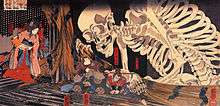Gashadokuro
Gashadokuro (がしゃどくろ/ 餓者髑髏, literally "starving skeleton", also known as Odokuro, literally "giant skeleton") are mythical creatures in Japanese mythology.

Description
The Gashadokuro are spirits that take the form of giant skeletons and are fifteen times taller than an average person, said to be created from the amassed bones of people who died of starvation or in battle, without being buried. These yōkai roam after midnight, grabbing lone travelers and biting off their heads to drink their spraying blood. There is a way to know of their approach, as the victim would hear the sound of loud ringing in the ear. The Gashadokuro are said to possess the powers of invisibility and indestructibility, though Shinto charms are said to ward them off.[1]
In modern culture
The Gashadokuro is a yōkai that first appeared in print in the latter half of the 20th century. It was created by the authors of shonen magazines published from 1960–1970 and illustrated yōkai encyclopedias. Shigeaki Yamauchi's World's Bizarre Thriller Complete Works 2: Monsters of the World (Akita Shoten, 1968) compiled articles about yōkai by Saitō Ryokuu. At the same time, it was also picked up by Shigeru Mizuki and Satō Aribumi, and from their introduction, the Gashadokuro became more widely known from 1980 on.
The illustration in Arabumi's Illustrated Encyclopedia of Japanese Yōkai (1972) and the illustration by Mizuki both base the appearance of the Gashadokuro on the giant skeleton in Utagawa Kuniyoshi's ukiyo-e print, Takiyasha the Witch and the Skeleton Spectre. It has no direct connection to the Gashadokuro, but is said to have influenced modern depictions. Kuniyoshi's print was commissioned in the Edo period by Santō Kyōden for a yomihon, depicting a scene in which Taira no Masakado's daughter, Takiyasha-hime, summons a skeleton yōkai to attack the samurai Ooya Tarou Mitsukuni. Although originally described as many life-sized skeletons, Kuniyoshi depicted it as a single giant skeleton, as is characteristic of his work.
In the manga One Piece, one of the Straw Hat members, Brook the skeleton, disguises himself as a Gashadokuro in the Wano Arc.
In the videogame Nioh, the player must defeat a Gashadokuro boss created from the remains of the fallen soldiers of the Battle of Sekigahara.
In the videogame series Yo-kai Watch, the Gashadokuro is represented by a boss known as Gutsy Bones.
In the manga Bone Collection, the heroine, Paira, is a Gashadokuro.
In the stop-motion animated movie Kubo and the Two Strings, a giant skeleton appears as a minor antagonist.
In the anime In/spectre the protagonist rides on the shoulder of a gashadokuro
Similar yōkai
In the entry for Gashadokuro in Mizuki's book, a related tale from the Nihon Ryōiki is introduced. It tells of a man in Bingo Province (Hiroshima Prefecture) who is in a field at night and, hearing an eerie voice moaning, "My eye hurts," finds a skeleton there with a bamboo shoot growing from its eye socket. He removes the bamboo shoot and offers the skeleton dried boiled rice, upon which the skeleton tells him the story of its murder and its personal history, and rewards him for his kindness. Though this tale has been conflated with that of the Gashadokuro, the two are in fact unrelated, the Gashadokuro having originated in the later half of the 20th century.
References
- Jonathan Maberry (2006). Vampire Universe: The Dark World of Supernatural Beings That Haunt Us, Hunt Us, and Hunger for Us. ISBN 9780806528137.
